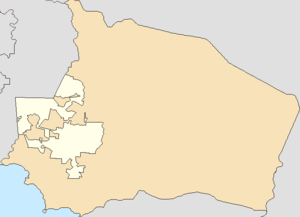Seremban
Seremban (Minangkabau: Soghomban or Somban) is a city and the capital of Negeri Sembilan, Malaysia, located within Seremban District. The city's administration is run by the Seremban City Council. On 9 September 2009, Seremban was to be declared as a city, but it was later deferred due to technical reasons. However, the idea of granting city status has been brought up again and Seremban is expected to become a city in 2020. Seremban officially gained city status on 20 January 2020.[1]
Seremban Soghomban, Sungei Ujong | |
|---|---|
City and State Capital | |
| Other transcription(s) | |
| • Chinese | 芙蓉 |
| • Tamil | சரம்பன் |
| • Jawi | سرمبن |
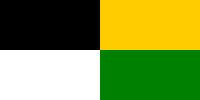 Flag 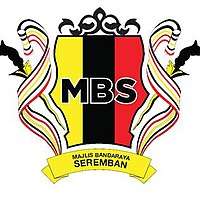 Seal | |
| Nickname(s): Somban, Sban | |
| Motto(s): Mengutamakan Perkhidmatan Segera | |
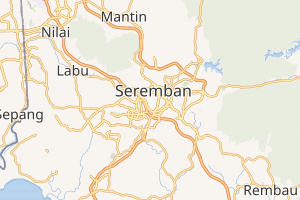
Location of Seremban in Negeri Sembilan | |
| Coordinates: 02°43′20″N 101°56′30″E | |
| Country | |
| State | |
| District | Seremban District |
| Establishment | 1840 as Bukit Pasar 1878 as Selimban 1899 as Seremban |
| Granted municipal status | 1979 |
| Granted city status | 20 January 2020[1] |
| Government | |
| • Administered by | Majlis Bandaraya Seremban |
| • Mayor | Dato' Haji Zazali Bin Salehudin[2] |
| Area | |
| • City and State Capital | 959 km2 (370 sq mi) |
| • Metro | 2,980 km2 (1,150 sq mi) |
| Elevation | 79 m (259 ft) |
| Population (2015)[3] | |
| • City and State Capital | 620,100[4] (9th) |
| • Density | 489.00/km2 (1,266.51/sq mi) |
| • Metro | 824,300[5] |
| • Demonym | Serembanese |
| Time zone | UTC+8 (MST) |
| • Summer (DST) | Not observed |
| Postal code | 70xxx, 71xxx |
| Mean solar time | UTC + 06:46:48 |
| National calling code | 06 |
| License plate prefix | Nxx (for all vehicles include taxis) |
| ISO 3166-2 | MY-05 |
| Website | mpsns |
Toponymy
Seremban was founded as Sungei Ujong (or Sungai Ujong), named after a nearby river of the same name. While the town was renamed Seremban thereafter, the Sungai Ujong name most prominently persists as a street name for a road adjoining the southern side of town (Sungai Ujong Road, or Jalan Sungai Ujong).
The town is also referred alternately as "Fu Rong" in Mandarin or "Fu Yong" in Cantonese (Chinese: 芙蓉,literally "hibiscus") among the Chinese-speaking community.
History
An ancient settlement, Parameswara (king) reportedly visited Sening Ujong, as it was originally known and growth took off after the discovery of tin ore in the 1870s like most major towns in Peninsular Malaysia. The discovery of tin in a nearby area called Rasah, saw an influx of Arab, Malay and Chinese immigrants to work on the mines and trade there. Most of the local Malays were farmers.
Renamed as Seremban, the town flourished not only as a mining area but also a business centre. The Linggi River served as the sole outlet to ferry tin and supplies in and out of the town. Revenue came not only from tin trade but also from the large amount of taxes collected, much to the displeasure of the traders and the British colonialists at the neighbouring port of Malacca.
The local chieftains, namely the Dato' Kelana and the Dato' Shahbandar of Sungai Ujong were at odds with each other on the rights to collect taxes and ownership and control of the mines. The rivalry to assert influence and authority opened the door for British intervention in Negeri Sembilan. The British sided with the Dato' Kelana upon invitation and defeated the forces of the Dato' Bandar who was later sent into exile to Singapore. In a show of gratitude to the British for helping him win the war, the Dato' Kelana had no choice but to accept a British Resident whose job was to advise him on matters other than religion and Malay customs.
Captain Murray was appointed the first resident and later set-up his residence at Channer Road, now renamed Jalan Dato' Siamang Gagap. Soon after, the people living around Rasah moved to Channer Road for the sake of security and its orderly administration.[6]
City status
Seremban is one of four state capitals that has not achieved city status (Bandar raya); the other three being Kota Bharu (Kelantan), Kuantan (Pahang) and Kangar (Perlis). However, the Ministry of Housing and Local Government has already approved Seremban's application to be declared a city on the 9th of September 2009. To achieve city status, the state government has agreed that Majlis Perbandaran Nilai and Majlis Perbandaran Seremban will be merged, with that decision likewise being approved by the federal government in 2012.[7]
Then Menteri Besar Datuk Seri Mohamad Hasan said during Tuanku Mukhriz's birthday
The state government wants to ensure all the necessary infrastructure, public transport and amenities and services which include garbage collection and safer neighbourhoods, were in place before it did so.[8]
On 13 December 2017, then Menteri Besar of Negeri Sembilan, Mohamad Hasan stated that Seremban will get city status in 2018.[9] In order to get city status, both Seremban and Nilai Municipal Council will be merged to form a new local authority, Seremban City Council.[10] The merger of two local authorities are now in the last stage. However, he said, the merging of the two entities would not involve the reduction of staff or higher assessment rates in the Seremban area, as increasing rates was not a prerequisite for attaining city status.
So, I hereby announce that the assessment rates in Negeri Sembilan for 2018 will not be raised[11]
In February 2018, a further announcement was made regarding the formation of Seremban City Hall (Dewan Bandaraya Seremban), which was poised to be completed in April. However, the official declaration of Seremban as a city will only occur in January 2019, in conjunction with the birthday of the state's ruler Tuanku Muhriz (January 14).[12] After the change in the ruling coalition after the 14th General Election ushered in a new state government, the new Mentri Besar Aminuddin Harun announced his decision to push back the official promotion towards the end of the year, citing the inability of contractors to complete refurbishment works at the new City Hall in time. However, the postponement will allow the authorities time to iron out any flaws in Seremban's infrastructure and amenities.[13]
Two municipal administrators, Seremban City Council (Majlis Perbandaran Seremban) and Nilai City Council (Majlis Perbandaran Nilai) officially merged into a new administrator, Seremban City Council (Majlis Bandaraya Seremban) on 1 January 2020. On 20 January, Seremban's status as a city was officialised in a declaration ceremony.[1]
Geography

Seremban is situated about 60 kilometres south of Kuala Lumpur (the capital city) and about 30 kilometres inland from the coast. It is located in the Linggi River valley, at the foothills of the Titiwangsa Range. The terrain is generally hilly, and the soil is mostly reddish laterite soil, suitable for the cultivation of rubber and palm oil, thus making Seremban the agricultural centre for the state. Since the establishment of Seremban, the Linggi River has played an important role in the development of the town. During the boom period of tin mining, the Linggi River served as the major transportation route for tin traders. Today, it is one of the major sources of water for Seremban and Negeri Sembilan.
Weather
The climate of Seremban, like most parts of West Malaysia, is generally hot and humid (tropical) with a mean temperature of about 26–30 degrees Celsius. Most of the rainfall is experienced during the inter-monsoon periods of April and October. The weather remains generally dry for the rest of the year with occasional showers.
Transportation

Public transportation
The rail connection was first constructed in the late 1890s as a stop on the Kuala Lumpur–Singapore main line, and until today, the Seremban railway station (code: KB13 ) still serves as one of the major stops along the line. The station also serves as the southern terminal of the Keretapi Tanah Melayu electrified commuter network, KTM Komuter, which links the town to Kuala Lumpur and the Klang Valley on Seremban Line.[14] Since October 2015, the Komuter service has been extended to Gemas, though passengers are required to alight at Seremban and switch trains to the Gemas extension line (much akin to the Tanjung Malim–Rawang stretch).
Negeri Sembilan is one of the two states in Malaysia that are not accessible via air transportation (Perlis being the other state). However the Kuala Lumpur International Airport (KLIA) is less than a 30 minutes drive from Seremban, essentially making the airport closer to Seremban rather than Kuala Lumpur.
Car
Federal Route ![]()
![]()
![]()
![]()
![]()
For a faster alternative, the North–South Expressway ![]()
![]()
Demographics
According to the 2010 census, there are 514,909 Malaysian citizens in the administrative district of Seremban. They consist of 56.4% Bumiputera, 26.2% Chinese and 17% Indian and 0.5% others excluding non-citizens. There are an additional 41,026 non-citizens.[15]
| Ethnic groups in Seremban, 2010 census[15] | ||
|---|---|---|
| Ethnicity | Population | Percentage |
| Bumiputera | 290,282 | 52.2% |
| Chinese | 134,572 | 24.2% |
| Indian | 87,663 | 15.8% |
| Others | 2,392 | 0.4% |
| Non-citizens | 41,026 | 7.4% |
| Total | 544,935 | 100% |
Culture
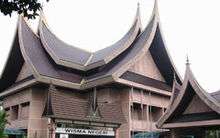
Historically, Negeri Sembilan is influenced by the Minangkabau's and thus, Seremban is the centre of the Minangkabau culture in Malaysia. Minangkabau, derived from the Malay word menang kerbau, which means "winning buffalo", are famous for their unique roof architecture which resembles buffalo horns. Many buildings in Seremban adapted this feature, such as the Seremban Municipal Council Hall, the Wisma Negeri and the State Museum.
People of Negeri Sembilan are also known for the practice of an ancient Malay tradition called Adat Perpatih, where women are given a higher social status than men.
Sports
Seremban currently serves as the home ground of Negeri Sembilan football team. The team is the state representative of Negeri Sembilan in the second tier Malaysia Premier League. They play their home games in the 45,000 capacity Tuanku Abdul Rahman Stadium which is located in Paroi on the outskirt of the city.
Cuisine

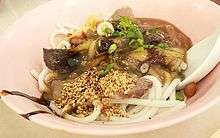
Seremban is famous for its special delicacies comprising Malay, Chinese, and Indian cuisine. Among the local cuisine is Seremban Siew Pau (Chinese: 芙蓉烧包) that is well known throughout the country. It is a flaky pastry bun filled with meat fillings which has been traditionally pork or the halal chicken filling.[16]
Seremban is also well known for its Nasi Padang or Minangkabau dishes. It is basically a meal of rice eaten with dishes of recipe which originated from Padang, Sumatra. One of the local dishes is Gulai Masak Lemak Cili Api which is fish or meat cooked in coconut gravy mixed with turmeric and cili padi (bird's eye chili).
Seremban is famous for baked crabs with many establishments situated along Jalan Tuanku Munawir (Chinese: 芙蓉烧蟹)[17] and beef noodles (Chinese: 牛腩粉),[18] especially the beef noodles food stalls here which have survived for more than a generation. Nowadays, these beef noodles attract a tourists from outside the state to Seremban with its thick, slick gravy and peppery, sticky sauce sprinkled with peanuts, salted vegetables, spring onions and sesame seeds.
Local desserts include ABC or air batu campur meaning shaved ice with brown sugar syrup and rose flavouring, corn, beans, and cendol. To date ,The cendol in seremban town is better than teochew cendol in Penang.
Tourism
Seremban Square
Fish pond, the name given to an area of open land in the Seremban town area which has long been the synonym and subject of complaints of the city community has recently been given a new look. No more is there a barren, neglected view which was claimed to be the breeding ground for mosquitoes in the heart of Seremban Town Centre.
Recently, the Seremban Square which decorates the main entrance to the Seremban town began to attract attention and has since turned into a tourist spot. In the Seremban Square area there are also Malaysian flagpoles that reach up to a length of a 100 feet.
The Seremban Municipal Councils hoped that the Seremban Square, which began its operation in May 2008, would be appreciated and used properly by the public. It was hoped that it would continue to be used by all walks of life, not just for the present but would continue to be a valuable heritage for the future generation.
Ostrich Farm
Renowned as a family recreational centre, the Jelita Ostrich Show Farm in Jalan Jelebu not only focuses on breeding activities in particular, but also capitalises on all speciality of the bird species.
State Museum
The Negeri Sembilan Museum was established in 1953 when the 8th Yamtuan or Ruler of Negeri Sembilan, Tuanku Abdul Rahman gave his consent for the relocation of the Ampang Tinggi Palace from Kuala Pilah to the Taman Bunga at Jalan Dato' Hamzah, Seremban and was turned into the State Museum.
Seremban Lake Garden
Seremban Lake Garden is the most popular recreational and leisure centre in Seremban which has attracted the attention of many visitors especially during public holidays and weekends. This Lake Garden is one of the oldest natural lake gardens in Malaysia.
Seremban 2 Recreational Park
Seremban residents and also town folks in search of a recreational destination with the family, come and visit the S2 City Park, during weekends or school holidays. Arriving at this six-acre area, visitors will be greeted with the breath-taking landscapes as well as a variety of colourful kite decorations flying freely in the sky.
Malaysia Park
Malaysia Park is in line with the noble intention of the government in ensuring that each town is not only modernised but also parallel towards town greenery. the Seremban Municipal Council has identified Malaysia Park as one of the Public Parks which may be developed to accommodate the recreational and leisure as well as tourism needs for Seremban town.[19]
The Church of The Visitation
It is the oldest parish in the Roman Catholic Archdiocese of Kuala Lumpur since 1848. The church is located in the centre of Seremban town with a sprawling 2 acres that includes the historical Parochial House and the Visitation Hall and Formation Centres and the Wisma Visitation. Its neo-Gothic architecture is truly a central landmark of the town and has been described as “one of the most beautiful in the mission.”
Centipede Temple
Perched on top of a hill in Ulu Temiang, Seremban lies the Centipede Temple (or Then Sze Temple). Centipedes roamed freely in and out of the temple grounds and it is believed that if one spots a centipede they can expect some good fortune.
Town areas
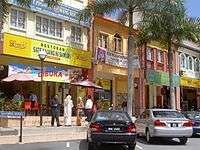
Bandaraya Seremban core
- Seremban
- Rasah
- Rasah Jaya
- Rahang
- Mambau
- Senawang
- Temiang
- Lobak
- Paroi
- Bukit Chedang
- Bukit Blossom
- Seremban 2
- Ampangan
- Oakland
- Bukit Kepayang
- Kemayan
- Sikamat
- Seremban 3
- Taman Permai
Outer Bandaraya Seremban
- Nilai
- Bandar Baru Nilai
- Rantau
- Mantin
- Sungai Gadut
- Labu
- Lenggeng
- Taman Seremban Jaya
- Bandar Seremban Selatan
- Taman Tuanku Jaafar
- Rasah Kemayan
- Seremban 2 Heights
- Bandar Sri Sendayan
- Bandar Ainsdale
- Gadong Jaya
- Bandar Enstek
- Pantai
- Ulu Beranang
- Pajam
Seremban 2
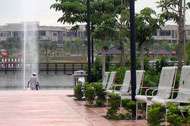
Seremban 2 is a new satellite township about 4 kilometres south-east of the existing old Seremban town centre. Located on the western side of the North–South Expressway, Seremban 2 is a planned township built on former oil palm estate land with the aim of relocating the administrative and business district from the crowded old town centre to a more organised area.
Spanning over 2,000 acres (8 km2) of land, Seremban 2 will be the site of the new
- Seremban District administrative offices
- Seremban Court Complex.
- District Police headquarters
- State Fire Brigade headquarters
The RM2 billion township will also sustain a large portion of the population of Seremban through various housing estate projects in and around Seremban 2 such as
- Green Street Homes
- Sri Carcosa
- Central Park
- Emerald Park
- Garden Homes
- Garden Avenue
- Garden City Homes
- Vision Homes
- S2 Heights
- Park Avenue
- Pearl 132
The residents here enjoy many facilities with ÆON Seremban 2 Shopping Centre, City Park, Seremban 2's very own Lake Gardens and comparably less traffic than the town centre.[20]
Economy
Being an administrative centre since its early days have helped to cement Seremban's place as the region's primate city. The state, which been home to a number of multinationals from Japan, South Korea, the United States and the European Union. The manufacturing sector today forms the backbone of the state economy, contributing almost half of the state's gross domestic product (GDP), followed by services and tourism (40.3%), agriculture (6%), construction (2.2%) and mining (0.3%).[21]
Retail
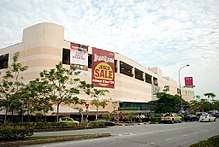
Seremban is the business and commercial centre for most towns and villages in Negeri Sembilan. During the weekends, residents from outlying areas come to Seremban by commuter train or buses to shop in Seremban. Amway opened their first concept shop in Seremban in August 2008 as an ongoing expansion strategy to give its distributors and customers a new shopping experience.[22]
Terminal One Shopping Centre ("T1", previously known as Terminal One Mall) is located at the heart of Seremban. It was built in 1996.[23][24]
AEON Seremban 2, one of the premier shopping destinations in the town, was the only ÆON outlet operated in the state till February 2010, when ÆON launched their grand opening of ÆON Big at Seremban Forest Heights that replaced the old Carrefour.
Besides T1 and AEON, many shopping outlets are concentrated in the town centre; Wisma Punca Emas, KM Plaza, The Store, Palm Mall, Era Square and Parkson Seremban Prima which replaced Seremban Parade. As the population increased over time, it attracted five major hypermarket chains in Malaysia to set up store in Seremban, namely Giant Hypermarket, Tesco Extra, Econsave and Mydin (2 outlets).
Apart from shopping complexes, Seremban contains a number of neighbouring commercial districts including Taman AST, Era Square, Permai Avenue, Oakland and Kemayan Square amongst other areas.
Seremban also has designated numerous zones in the city to market locally manufactured products such as antiques, textiles, fabrics and handicrafts. The local municipal council has gazetted Jalan Utam Singh as a morning flea market during the weekend.[25] In 2009, Sungai Ujong Walk located in Jalan Dr. Murugesu was opened by the local council president. The walk follows the example of the well known Jonker Street in Malacca, providing 72 business sites with 30 lots selling foodstuffs and beverages. The rest of the space serves as a stage for performances and cultural shows. It is envisioned as a future location that will revive the atmosphere at night besides enlivening the surrounding areas.[26]
Infrastructure
Health
Seremban has a number of hospitals and medical centres, which include a government hospital and private owned hospitals.
Tuanku Ja'afar Hospital, formerly known as Seremban General Hospital is the state and referral hospital for the state of Negeri Sembilan. Established in 1930 with total capacity 800 beds and 20 clinical specialities and various supportive services. Situated at Bukit Rasah, Seremban, the hospital occupying an area of 212 acres (0.86 km2) of land.
The other hospitals include Columbia Asia Medical Center, which opened in 1999 and now has 80 beds and offers outpatient and inpatient specialist services, a 24-hour clinic and emergency services.
In 2004 a new hospital was established, Seremban Specialist Hospital which has total capacity of 109 beds. The hospital located at the outskirt of Seremban which is just behind State Museum.
Negeri Sembilan Chinese Maternity Hospital is also a private hospital that has 75 beds. It located along Jalan Tun Ismail.
There is also a hospital in Senawang, the 101 beds Senawang Specialist Hospital (SSH) which opened in 2008.
Politics
Seremban is currently represented in the Dewan Rakyat of the Malaysian Parliament by Anthony Loke Siew Fook of the DAP.
On the state level, Seremban supplies 6 seats to the Negeri Sembilan State Legislative Assembly:
Currently the DAP controls three out of these six seats: Nilai, Lobak and Temiang; PKR holds Sikamat and Ampangan while Lenggeng is currently held by AMANAH.[27][28]
Certain wards of Seremban, though administered by the Seremban City Council, are actually located in other parliamentary constituencies; for instance, Paroi is represented by Rembau constituency, while Mambau, Bukit Kepayang, Rahang and Senawang are located within the borders of Rasah parliamentary constituency.
International relations
Sister cities
Seremban currently has one sister city:
|
References
- Azzman Abdul Jamal (20 January 2020). "Seremban diisytiharkan bandar raya" [Seremban declared as a city]. Berita Harian (in Malay). Retrieved 5 February 2020.
- Rashitha A. Hamid (16 June 2007). "Profile of Haji Abd. Halim". Majlis Perbandaran Seremban. Archived from the original on 2 November 2007. Retrieved 29 August 2007.
- Helders, Stefan. "Metropolitan areas in Malaysia". World Gazetteer. Archived from the original on 5 December 2012. Retrieved 4 December 2007.
- http://www.ns.gov.my/images/contents/DataPentingNS2015.pdf
- Seremban Urban Area Archived 30 December 2014 at the Wayback Machine
- "Administration in Seremban". Majlis Perbandaran Seremban. Archived from the original on 8 January 2008. Retrieved 14 February 2008.
- "City status for Seremban". Utusan Malaysia. Retrieved 14 February 2008.
- "Seremban on the right track". The Star. 14 January 2011. Retrieved 24 February 2011.
- "Seremban City Status 2018".
- https://www.bharian.com.my/berita/wilayah/2017/12/362934/seremban-jadi-bandar-raya-2018
- https://www.nst.com.my/news/nation/2017/12/314130/seremban-get-city-status-2018-mb
- https://www.thestar.com.my/news/nation/2018/02/28/negri-mb-seremban-and-nilai-councils-to-be-merged-in-april/
- https://www.thestar.com.my/news/nation/2018/09/05/mb-serembans-city-status-deferred-to-end-2019//
- "Commuter service in Seremban". Keretapi Tanah Melayu Berhad. Archived from the original on 11 October 2007. Retrieved 14 February 2008.
- "2010 Population and Housing Census of Malaysia" (PDF). Department of Statistics, Malaysia. p. 66. Archived from the original (PDF) on 5 February 2013.
- Lee Thean Seng. "The Legendary of Siew Pau". Lee Thean Seng. Retrieved 30 July 2011.
- "Seremban Baked Crabs". Retrieved 25 October 2011.
- Thomas. "Seremban Beef Noodles". Thomas. Retrieved 21 September 2011.
- "Archived copy". Archived from the original on 27 September 2015. Retrieved 26 September 2015.CS1 maint: archived copy as title (link)
- Seremban 2 Archived 28 August 2008 at the Wayback Machine
- "Multi-pronged approach to maintain growth". The Star (Malaysia). 14 January 2011. Retrieved 24 February 2011.
- "Outlet is direct-selling company's first in the Klang Valley". The Star (Malaysia). 4 August 2009. Retrieved 27 August 2009.
- "Seremban council takes over bus terminal". Fox News. 16 October 2003. Retrieved 26 January 2008.
- Terminal One Shopping Centre Archived 18 December 2014 at the Wayback Machine
- Mohd. Yassir Jaafar (16 March 2009). "Keunikan Pasar Warisan". Utusan Malaysia. Retrieved 26 August 2009.
- "Sungai Ujong Walk bakal tandingi Jonker Street". Utusan Malaysia. 6 December 2008. Retrieved 4 October 2009.
- "14th GE Results". The Star. Retrieved 6 September 2018.
- "Ahli Dewan Undangan Negeri Sembilan". DAPMalaysia.org. Retrieved 24 January 2016.
- "Kota Kembar" (in Indonesian). Pemerintah Kota Bukittinggi, Propinsi Sumatera Barat. Archived from the original on 21 December 2015. Retrieved 21 December 2015.
External links
| Wikimedia Commons has media related to Seremban. |

- Majlis Perbandaran Seremban
- KTM Komuter Seremban Station
- Seremban Maya
- Virtual Drive Through Street of Seremban
- Seremban Live
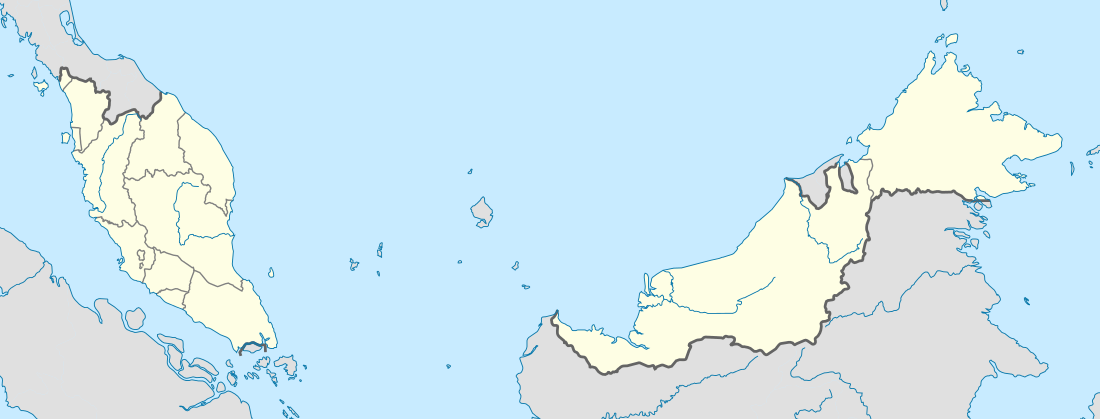

.svg.png)
